![]()
![]()
![]()
Use LEFT and RIGHT arrow keys to navigate between flashcards;
Use UP and DOWN arrow keys to flip the card;
H to show hint;
A reads text to speech;
44 Cards in this Set
- Front
- Back

Botticelli Lamentation Oil on panel 1490 |
1. It presents an example of what Savonarola's ideals in art: no pagan references and the covering and careful approach of sacred bodies. 2. Botticelli painted primarily religious works after this-> exemplifying how he was affected by Savonarola (as many artists who stayed in Florence were, others fled and were better like M)
|
|
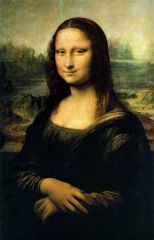
Leonardo Da Vinci Mona Lisa Oil on panel 1500 |
1.Brings up the question of what is naturalism because he has eliminated use of outline to yet the background cannot be clearly identified as certain foliage, etc. 2. Is an example of colore tradition as it is hard to make up any harsh outlines and light accentuates her face and folds in fabric. |
|
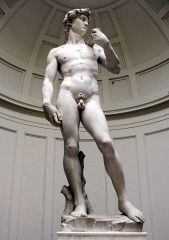
Michelangelo David Marble 1500 Piazza della Signoira, Florence |
1. David is a symbol of intellect and a sign of Florence who resonate w/him being underdog against Goliath. Its moving to Palazzo della Signora shows sense of community & how achieved through art. 2. Great muscularity as opposed to Donatello's David (more teenage) possibly to show M's infatuation with muscle and the body (making a clear brand of his style). |
|
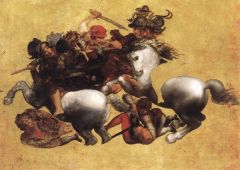
Da Vinci Study for the Battle of Anghiari Oil on panel 1500 Florence |
1. Is a historia painting for the Hall of the Five Hundred, showing the triumphs of the Republic before Medici rule in order to oppose them in this new Republic phase. 2. Is a representation of how the art community struggled to find self representation after the Medici were kicked out and does so by showing triumphs against Siena particularly (message of unity in defeating enemy). |
|
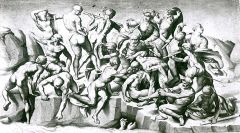
Schiavonetti(orig.Michelangelo) Study for the Battle of Cascina Engraving 19th cty. copy of 16th cty. original Florence |
1. One of 1st instances of cartoon being the "final" product- artists fled to study it & only some allowed to see it. Shows a transition in art culture. 2. The entangle of masculine bodies derives from separate studies and shows M's fascination with muscles and contortion whilst also challenging viewer to untangle the image. |
|

Sangallo Virgin & Child w/St.Anne Marble 1520 Orsanmichele, Florence |
1. Anne is portrayed as older which was rare and difficult to do b/c it was thought that all divine people were to be perfect & forever young. 2. Despite being a republican symbol, the Medici choose to restore this once back in power, demonstrating the use of appropriation of art to manipulate others. 3. Jibberish Hebrew only understood when read aloud ("I am the light of the Lord") |
|
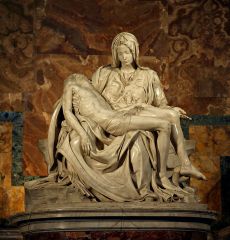
Michelangelo Pieta Marble 1500 Old St. Peter's, Rome |
1. Ever young Madonna & lack of gore/wound on Christ demonstrates Michelangelo's following of Neo-Platonism as divine people were thought to never age and look perfect b/c perfection of soul is reflected in looks too. 2. Thought to possibly reference Artemis, goddess of nurture, which would then combine classicism and religion to create a new kind of devotion. |
|
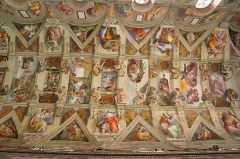
Michelangelo Sistine Ceiling Fresco 1500 Sistine Chapel, Vatican City |
1. Michelangelo's Sonnet with Personal Caricature tells how much he hated this job and how he felt he really wasn't a painter-> shows society's influence on his reputation 2. Displays scenes of Old and New Testaments and frames them in faux architectural molding and tapestries-> concisive and innnovtive |
|
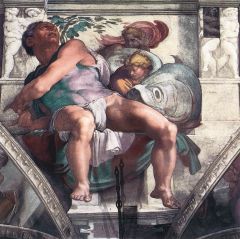
Michelangelo Sistine Ceiling (det. Jonah & the Whale) Fresco 1500 Sistine Chapel, Vatican City |
1. Jonah's feet look like they're hanging out and as though he could slip out onto us (M's skill in perspective and optics) 2. Uses color cagniate (colors that have one shade different than the other) to make the work seem more 3D-> innovative |
|
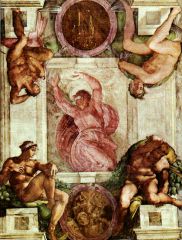
Michelangelo Sistine Chapel (det. God Separating Light from Darkness, the Igundi) Fresco 1500 Sistine Chapel, Vatican City |
1. Ignudi aren't related to narrative story and act as supports to scenes but are all different-> ambiguity as to their meaning-> maybe to make people look at it more? 2. God is in contropposto position-> putting him in a classical stance-> mixing the two-> would've been looked down upon by later Council of Trent |
|
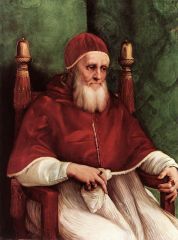
Raphael Portraits of Pope Julius II Oil on panel 1510 Rome |
1. The green of the background works to reference the church, sacred space, or even Julius as a living relic himself (messenger to Christ on earth)-> display of power to people. 2. But the militaristic pope is displayed as quiet, old, humble man w/o triple crown or much of papal clothes-> why? to win over his people? |
|

Raphael Fire in the Borgo Fresco 1510 Vatican City |
1. Façade of Old St. Peter's which had been torn down earlier by Julius II serves as a historical record in art. 2.Scene of Leo IV protecting Borgo & city from fire by blessing it-> showing his power-> propaganda 3. Weird layout-> is most important the figures on the sides in foreground? |
|
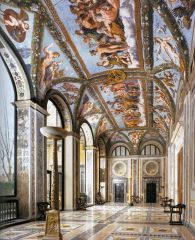
Raphael and workshop Loggia of Cupid & Psyche Fresco 1510 Rome |
1. Commissioned for Agostino Chigi and has hidden references to genitalia, therefore demonstrating Chigi's eccentric personality. 2. Ceiling is coated with bodies that actually look feminine and not a lot of attention to the background, most of focus is on figures themselves, exposing the important concepts of art in this time. |
|
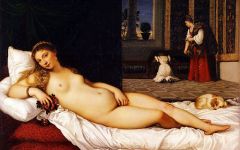
Titian Venus of Urbino Oil on Canvas 1530 |
1. The women behind are opening her casone (drawer with private image of naked man on inside) and naked woman imply it is for private setting. 2. The woman is not a goddess but has a Venus puttica pose and the face looks like one of models Titian used before-> mix of classics with contemporary. |
|
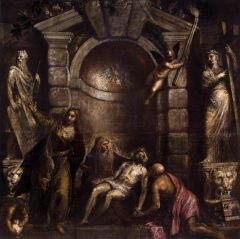
Titian Pieta Oil on canvas Left incomplete 1570 |
1. In the bottom right corner, there is a small ex-voto and family crest depicting Titian himself to try and get in good after death (meta-painting). 2. Made for his funerary monument but was not accepted by church after his death-> shows problems w/Post Tridintine references (doesn't like real people ) |
|
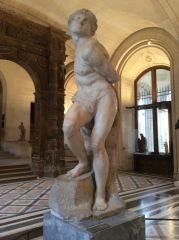
Michelangelo Slaves (see back for other) Marble 1510 Rome |
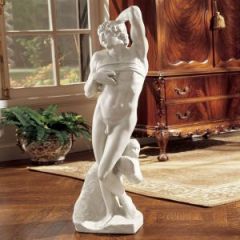
1. Originally intended to be given to Francis I of France to elicit his help in defense against Medici (exemplifies gift giving cycle). 2. Slaves could represent colonies subdued by Julius/how his tomb restrained by his death/personifications of liberal arts? |
|
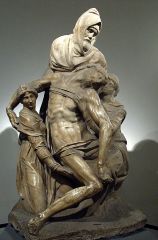
Michelangelo Pieta 1550 (left unfinished) Florence |
1. Michelangelo appears to be Nicodemus and aligns himself and puts himself as the focus on top of Christ (would've been Tridentine problem-> why it's unfinished?) 2. Different than usual pietas as Christ is almost completely blocking off Mary and Mary Magdalene is so small (probs a later addition by someone else) |
|
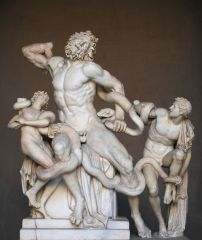
Laocoon Marble 1st century CE Rome |
1. This was one of several works discovered and then restored. Many works like this took on completely different meanings once restored because it was thought Renaissance artists were more advanced. 2. This excavated work was believed to be carved from a single block of marble and inspired Sangallo to become ambitious with sculpting from single blocks too. Shows the competiveness amongst contemporaries & ancestors. |
|
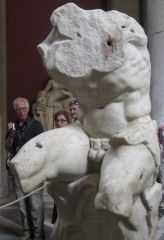
Torso Belvedere Marble 1st century CE Rome |
1. Many artists used this form as a basis for their work, like Michelangelo and Bronzino in his Portrait of Cosimo I as Orpheus. 2. Possibility it is Hercules sitting on an animal pelt, but there is significance in its not being altered/remodeled after excavation because it is so influential as a basic model for artists. |
|
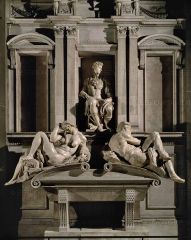
Michelangelo Tomb of Guiliano de' Medici, Duke of Neumors Marble 1530 New Sacristy, San Lorenzo, Florence |
1. Depictions of the dukes don't look like them because Michelangelo argued that in 100 years, no one would know what they looked like so might as well make them appear "perfect" (because book is defined by cover). 2. Notte/Night became a poetic symbol as people tried to awaken her and she personified ideal female beauty. |
|
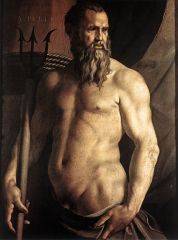
Bronzino Portrait of Andrea Doria as Neptune Oil on canvas 1530 |
1. Taking known ruler and presenting him as something greater than himself through connotations (ruler of a sea civilization so Neptune). Shows validation of rule through art? 2. Skin is very young looking despite face and just barely covers genitals-> power in nakedness/being open to his people? |
|
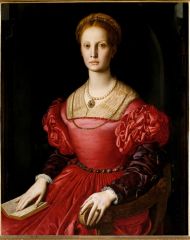
Bronzino Portrait of Lucrezia Oil on canvas 1540 Florence |
1. Is holding a book of hours with Song of Songs reference (written by David= Florence symbol) to show her religious affiliation and hide her real Protestantism? 2.Light figures emerging out of darkness like with Da Vinci except she has a large energy presence that Mona Lisa didn't where it seems like she could jump out, especially with her stark head-on gaze. |
|
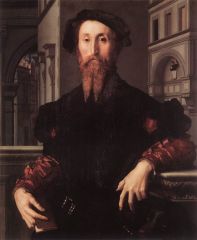
Bronzino Portrait of Bartolomeo Oil on canvas 1540 Florence |
1. Good display of sprezzatura (calculated elegance/conceal artifice to look like you're not trying) practiced by artists of period, especially Bronzino, with pose and fancy robes. 2. Is in a diptych with wife so that they hold eye contact with each other forever-> artwork displaying relationships and identity |
|
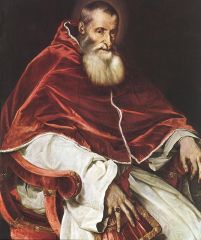
Titian Pope Paul III Farnese Oil on canvas 1540 Rome |
1. The face and hands contain a lot of detail while the clothes don't because Titian wanted to work with optics so that if you stood a certain distance, it would look like sumptuous velvet robes. 2. Like Raphael's portrait of Julius II, this portrays Pope calm and capable when he had to deal with the Reformation resulting from pushes from Protestants and needed to change the Catholic Church. |
|
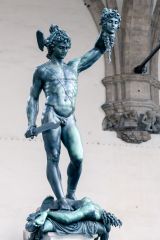
Cellini Perseus Bronze 1540 Florence |
1. Because of being made of bronze, its was believed it was made of pneuma (root of life) because according to Aristotle, anything w/vapor in it/watery had pneuma. So, Cellini like a god breathing life into his art. 2. Signs his work with the "Cellini was working on me" idea that Michelangelo had used, suggesting acheiropoeton and Cellini worked in all processes of bronze making, actively putting himself in complete authorship. |
|
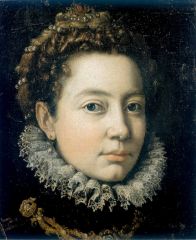
Sofonisba Self Portrait Oil on canvas 1560 |
1. She has the typical black dress and stiff collar of Spanish court, giving identity to piece as what point in life she is in (also plays with abstraction so it looks like lace from far way, think Titian). 2. Her father would promote her by giving out these portraits to other artists also exploiting the rarity of a female painter in these times. |
|
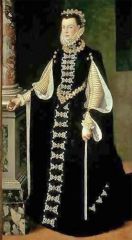
Sofonisba Portrait of Isabel of Valois Oil on canvas 1560 Spain |
1. She is holding a miniature of her husband, giving her identity and showing Anguissola's possible connection with Bronzino, w/giving Lucrezia marriage necklace in her portrait. 2.Shows Sofonisba's assosciaiton w/Spanish court, a job she landed by circulating her portraits thanks to her father's help (self-fashioning). |
|
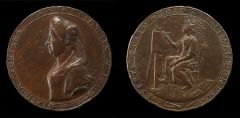
Lavinia Fontana Portrait Medallion of the Artist Bronze 1610 |
1. On backside is woman with bound mouth & at an easel (inscription- "Because of you I am in constant fervor")-> personification-> can we separate the artist from the personification of painting? 2. Fontana was known for not wanting to have her portrait in mass circulation so it shows maybe she did not want this coin meant for circulation, possibly Pope influenced her. |
|
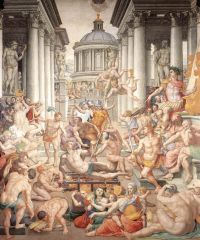
Bronzino Martyrdom of St. Lawrence Fresco 1560 San Lorenzo, Florence |
1. This composition depends on its quotations of other works & may not have been highly regarded b/c of that (e.g. men from Battle of Cascina, Adam from Sistine Chapel Creation of Adam, etc.) 2. Bronizno stood for disegno and despite differences with Titian's, both appear to be based off an original work by Raimondi (known for bad work within print culture). |
|
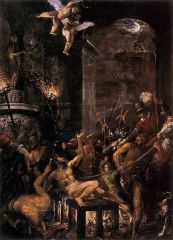
Titian Martyrdom of St. Lawrence Oil on canvas 1560 San Lorenzo, Florence |
1. Strives for a sense of hyper-realism attributable to Titian, and makes an avid example in chiaroscuro debate (contrast using extreme light & shadow); shows individual style whilst also new debate and trend 2. Titian had made several versions of this to appease the King of Spain. The 2nd version was more sketchy in quality to make the moment of death more anguished- shows progress/work in style. |
|
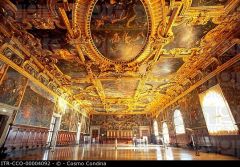
Hall of the Great Council After 1557 Doge's Palace, Venice |
1. Housed Tintoretto's Paradise, which was one of his largest works, off which he competed for and actually installed in the middle of the night to guarantee his winning the commission. 2. It was a political organ to Venice that made laws and was were many important people met, thereby making a commission here important for an artist. |
|
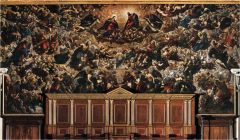
Tintoretto Paradise Oil on canvas 1590 Hall of the Great Council, Doge's Palace, Venice |
1. While competing to be commissioned for the space, Tintoretto did several sketches and plans that showed his evolution and how he changed to make Christ the focal point (renewal in its religious purpose/message?) 2. The scales held by an angel reference law and therefore send a message about the civilian's duty to God with government (propaganda like Lorenzetti's Effects of Good Government). |
|
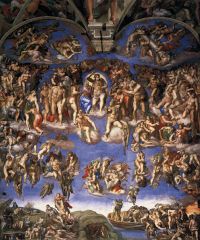
Michelangelo Last Judgment Fresco 1540 Sistine Chapel, Vatican City |
1. Was an instance of censorship, when the Council of Trent brought in Daniele da Volterra to "fix" the parts they deemed inappropriate (nude, positioning, etc.)-> censorship went well on into the next century 2. We have to look at print culture, like Ghisi's prints, to understand the original elements of the work-> shows the importance of prints and how it helped originality survive while also pushing it |
|
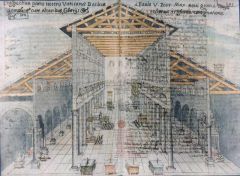
Old St. Peter's Basilica 320 Vatican |
1. repurposed basilica (in Ancient Romans used as a law house) to further distance themselves from pagan religion 2. Originally allowed burial ad sanctus (burying as close to St. Peter as possible) to offer new religious intimacy |
|
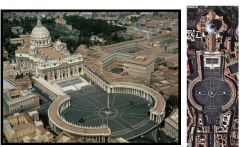
Carlo Maderno Façade of New St. Peter's Basilica 1600 Vatican |
1. Based some of design off of Jesuits and Ignatius Loyola's arguments for clarity, monumentality, simplicity, and a return to the church's origins 2. The façade has lots of layering and isn't strictly mathematical which shows new transition into new style (Baroque) |
|
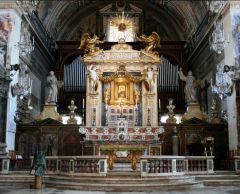
High Altar of Santa Maria in Aracoeli Pigment on panel, marble 1560 Santa Maria in Aracoeli, Rome |

1. Shows mission of Council of Trent b/c had been in several areas (e.g. monument) but was put in own tabernacle when renovations were being made to church. 2. Processed thru city during Black Plague-> think back to Megan Holmes on Icon Cults |
|
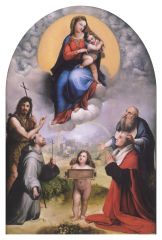
Raphael Madonna of Foligno Oil on panel 1510 Santa Maria in Aracoeli, Rome |
1. There's some debate that this was moved to the high altar at Santa Maria because after R's untimely death, he was considered divine and the work of a divine hand makes sense in the altar. 2. Brings up the theological question of if people liked it for its religious content or simply b/c it was made by Raphael (Council of Trent tried to prevent this). |
|
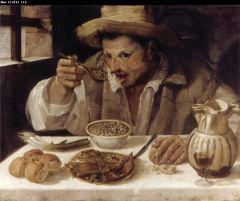
Carracci Bean Eater Oil on canvas 1590 |
1. There is a forced closeness in that the subject appears to have caught us in the act of looking at him, showing you don't necessarily need "skill" to make an impact. 2. Is an example of what some at the time called genre painting: replicating what you see for benefit of viewer and artist, not to tell a story |
|
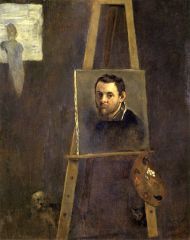
Carracci Self Portrait on an Easel Oil on panel 1590 |
1. Gives a sense of identity with the darkness and lack of figures that plays to his melancholy/tortured genius identity 2. The cat and dog are the only ones looking at us and the strange figure in the back leaves ambiguity that makes us question the intent of their inclusion (maybe make the viewer look more?) |
|

Carracci Farnese Gallery Fresco 1600 Palazzo Farnese, Rome |
1. Has faux framing all around to give the narrow space a sense of being like a loggia-> innovative technique 2. When the Weary Hercules is excavated, Annibale Carracci quotes it with several Hercules frescoes, showing that Carracci can go back to ancient painting and still be innovative. |
|
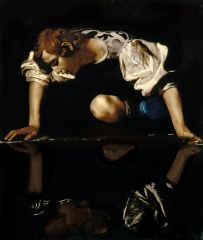
Caravaggio Narcissus Oil on canvas 1600 Rome |
1. Shows the conceit of pictorial illusion that takes precedent with the frustration of Petrarch not being able to have Beatrice talk back to him, referring back to ancient literature. 2.Has what will become Caravaggio's signature body emerging from darkness with what acts like a spotlight to emphasize the form of his body |
|
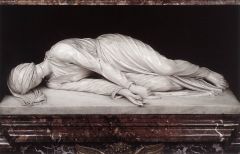
Stefano Maderno Santa Cecilia Marble 1600 Santa Cecilia in Trastevere, Rome |
1. Is an example of a way it was appropriate to display a women in post-tridentine times with the fabric covering her body and face as well as her position (questions authenticity though, is this really position she was found in?) 2. she is in a niche like loculus tombs/early Christian catacombs that connect her to Ancient Rome (Christian Antiquarianism) |
|
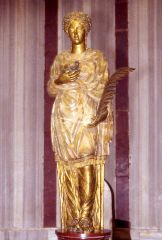
Nicolas Cordier Sant' Agnese Alabaster fragment, gilt bronze additions 1600 Sant' Agnese fuorie le mura, Rome |
1. She has many classical features and fragments and was justified b/c St. Agnes lived in these pagan times (when material would've been found) but was still a Christian figure (Christian Antiquarianism) 2. Lamb symbol and appearance reference humanism (still evident late in Renaissance) |
|
|
HALL OF THE FIVE HUNDRED, PALAZZO VECCHIO, FLORENCE
|
WHERE BATTLE OF CASCINA AND BATTLE OF ANGLIHARI WERE.
|

